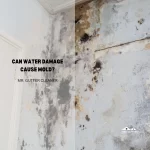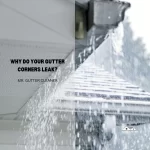Leaking gutter joints pose a significant risk to the structural integrity of homes, leading to potential water damage and costly repairs if not addressed promptly. This issue commonly arises from weather-induced wear, improper installation, or lack of regular maintenance.
Homeowners seeking to address this problem must first understand the causes behind gutter leaks to effectively implement a solution.
The repair process involves several key steps, beginning with the identification of the leak’s source, followed by thorough cleaning of the gutter joint.
The application of an appropriate sealant is crucial for ensuring a watertight seal. Additionally, reinforcing the joint with hardware can prolong the gutter’s lifespan and prevent future leaks.
Regular maintenance and inspection play vital roles in preventing gutter joint issues, highlighting the importance of proactive home care.
This guide aims to equip homeowners with the knowledge and tools necessary for fixing leaking gutter joints, thereby safeguarding their homes against water-related damages.
By following the guidelines outlined in this comprehensive guide, homeowners can effectively address leaking gutter joints and maintain the structural integrity of their properties for years to come.
What Causes Gutter Leaks?
Gutter leaks stem primarily from deterioration and adverse weather impacts. Over time, gutter joints deteriorate due to constant exposure to water, debris accumulation, and the natural wear and tear of materials. Factors such as rust in metal gutters or cracking in plastic variants play a crucial role in the weakening of gutter joints, making them susceptible to leaks.
How Do Gutter Joints Deteriorate?
Deterioration in gutter joints occurs from environmental exposure and material fatigue. Water retention, coupled with the presence of debris, exerts pressure on gutter seams, leading to cracks or gaps. Additionally, thermal expansion and contraction across seasons can stress gutter materials, causing joints to weaken or separate.
Table of Contents:
Can Weather Affect Gutter Joints?
Yes, weather significantly affects gutter joints. Extreme temperatures, heavy rainfall, snow, and ice can all exacerbate existing vulnerabilities in gutter systems. Ice formation, in particular, can lead to ice damming, where water freezes, expands, and forces joints apart, creating leaks.
Preparing to Fix a Leaking Gutter Joint
Effective repair of a leaking gutter joint begins with proper preparation, encompassing gathering necessary tools and adhering to safety measures.
What Tools and Materials Are Needed?
To repair a leaking gutter joint, homeowners need a ladder, gloves, a gutter sealant, a putty knife, and potentially replacement parts for severely damaged sections. Choosing the right sealant—whether silicone-based for its flexibility or a specific compound designed for gutter material—is essential for a lasting fix.
Safety Measures for Gutter Repairs
Safety is paramount when repairing gutter joints. Utilizing a sturdy ladder, wearing slip-resistant shoes, and having a partner for assistance can prevent accidents. It’s also important to be aware of overhead power lines and to avoid working in adverse weather conditions to ensure a safe repair process.
Step-by-Step Guide to Fixing a Leaking Gutter Joint
Fixing a leaking gutter joint involves identifying the source of the leak, cleaning the area, applying sealant, and securing the joint to ensure longevity. This process not only addresses the immediate issue but also contributes to the overall maintenance of the home’s exterior.
How to Identify the Leak Source?
Identifying the leak source requires a systematic inspection during or immediately after rainfall. Look for areas where water drips or flows unnaturally. Dry weather inspections might involve running water through the gutter to pinpoint leak locations. Marking these areas ensures accurate repairs.
How to Clean the Gutter Joint?
Cleaning the gutter joint is crucial for a successful repair. Remove debris and standing water. Use a brush to scrub the joint area, ensuring it’s free from dirt, rust, or peeling paint. A clean surface ensures better adhesion for the sealant.
Applying Sealant: What’s the Best Technique?
Applying sealant effectively involves selecting a gutter-compatible product. Cut the sealant nozzle at a 45-degree angle for precision. Apply sealant generously inside the joint and over any cracks, smoothing it with a putty knife or finger (wearing gloves). Allow it to cure as per the manufacturer’s instructions.
Securing Gutter Joints: How to Ensure Longevity?
Ensuring longevity of the repair involves checking and tightening fasteners around the joint. Replace damaged or rusted screws. Consider installing gutter guards to prevent debris accumulation, reducing future strain on joints.
Preventing Future Gutter Leaks
Preventative measures are key to avoiding future gutter leaks. Routine maintenance and timely repairs can extend the life of gutter systems, saving homeowners from costly damages.
Routine Gutter Maintenance: What Does It Include?
Routine maintenance includes regular inspections, cleaning out debris, and checking for signs of wear or damage. This should be done at least twice a year, in the spring and fall, to ensure gutters are prepared for seasonal weather changes.
When to Replace vs. Repair Gutter Joints?
Deciding between replacement and repair depends on the extent of damage. If leaks recur despite repairs or if there is significant wear, replacement might be necessary. However, for isolated issues, a repair may suffice. Consulting with a professional can help make this determination.
Professional Help vs. DIY: What Should Homeowners Consider?
When addressing a leaking gutter joint, homeowners face the choice between DIY repairs and seeking professional help. This decision hinges on evaluating the complexity of the gutter repair and the benefits of professional services versus the satisfaction and potential savings of a DIY approach.
Evaluating the Complexity of Gutter Repair
The complexity of gutter repair varies with the extent of damage and the homeowner’s comfort level with home maintenance tasks. Minor leaks may be manageable for those with basic DIY skills, but extensive damage or hard-to-access gutters might necessitate professional intervention. Consider factors like the height of the gutters, the nature of the damage, and your own safety and expertise before deciding.
Finding a Reputable Gutter Repair Service
Choosing the right gutter repair service is crucial. Look for companies with strong reputations, verified reviews, and appropriate licensing and insurance. Reputable services offer warranties on their work, ensuring long-term protection against future leaks. Recommendations from friends or family and online reviews can guide you to trustworthy professionals.
Common Mistakes to Avoid When Fixing Gutter Joints
DIY gutter repair, while cost-effective, comes with pitfalls that homeowners should be aware of. Understanding common mistakes can prevent further damage and ensure the longevity of gutter repairs.
Why Is Overlooking Minor Leaks a Problem?
Ignoring minor leaks can lead to significant structural damage over time. Water infiltration can rot wood, damage foundations, and create an environment conducive to mold and pests. Addressing leaks promptly prevents minor issues from escalating into major repairs.
The Consequences of Using Incorrect Materials
Using incorrect materials or sealants that are not compatible with your gutter system can lead to premature failure of the repair. It’s essential to use products designed for gutter repair, as they offer the necessary flexibility and weather resistance to withstand environmental conditions.
FAQs on Fixing Leaking Gutter Joints
Addressing common queries can further empower homeowners to manage and prevent gutter joint issues effectively. This section aims to clarify frequent concerns, guiding through inspection routines and understanding the potential structural impacts of neglected gutter leaks.
How Often Should Gutter Joints Be Inspected?
Gutter joints should be inspected twice a year, typically in the spring and fall, to identify any leaks or vulnerabilities early. Additional inspections are advisable after severe weather events, such as heavy storms or snow, which can exacerbate or create new issues within gutter systems.
Can Leaking Gutter Joints Cause Structural Damage to a Home?
Yes, leaking gutter joints can cause significant structural damage to a home if left unaddressed. Persistent leaks can lead to water infiltration into the foundation, walls, and basement, promoting mold growth, wood rot, and erosion around the property. Early detection and repair of leaks are essential to prevent these costly damages.


